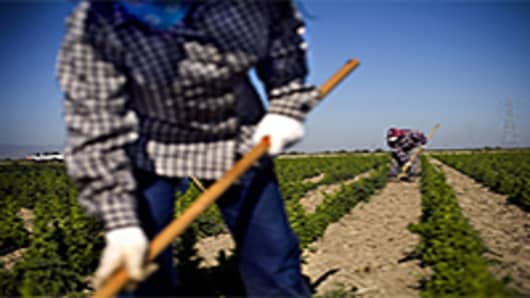Here’s a pretty typical version of the story, as told by the San Francisco Chronicle:
But the American Farm Bureau Federation and its California chapter believe there is plenty of reason to worry.
"There have been instances in which growers had to disc up whole crops because they didn't have the workforce to harvest," said Kristi Boswell, the Farm Bureau's director of congressional relations. She points to Georgia, where whole tomato fields were plowed under last year. "The workforce has been decreasing in the last two to three years, but last year it was drastic."
And farmers are saying this year is even worse.
In recent years, we’ve seen just how resilient this narrative really is. You’d think the idea of a labor shortage in the midst of on ongoing job drought would be laughed out of town. (Read more: When Are You Retiring?...How Does Never Sound?)
But somehow the story keeps getting told and taken seriously. According to the Farm Labor Shortage Mythologists, American citizens are just too lazy and would rather go jobless than work on a farm.
Here’s how the Chronicle puts it:
Growers have tried to hire more domestic workers and had hoped that with unemployment rates so high, they'd find local labor.
"But domestic workers don't stick around to finish the job," Boswell said. "It's labor-intensive and often involves hand-picking in grueling conditions."
Earlier this summer, as these stories started up once again, I tried to introduce some sanity into the discussion by pointing out that the dire farm labor shortage forecasts of 2011 had absolutely flunked the test of reality. As it turned out, 2011 was one of the best years on record for American farms.
One of the criticisms of my reading of the farm data was that the data about national farm income might have been concealing more local crises. Perhaps the national numbers had come in well despite the alleged “farm crisis,” because fields of soy and corn in the Midwest had done well, while the apples of Washington, peanuts of Georgia, and California fruits and vegetables went unpicked.
Not quite. State-by-state data released by the Department of Agriculture Wednesday has pretty much destroyed that critique.
Let’s start with California. The San Francisco Chronicle had warned:
Farmers across California are experiencing the same problem: Seasonal workers who have been coming for decades to help with the harvest, planting and pruning have dropped off in recent years. With immigration crackdowns, an aging Mexican population, drug wars at the border and a weakened job market in the United States, the flow of migrants has stopped and may actually have reversed, according to the Pew Hispanic Center, a nonprofit, nonpartisan public policy research firm that has been studying the trend.
So what happened?
Farm profits, what the Ag Department calls “net cash income,” in California rose from $11.1 billion in 2010 to $16.1 in 2011, an eye-popping 45 percent growth.
In Washington, the apple harvest was going to be devastated by a labor shortage. Farm profits instead rose from $1.98 billion to $3.14 billion, a 58 percent rise.
Georgia was going to have a “rancid harvest” due to its farm labor shortage, according to The Georgia Report. I guess those peanuts picked themselves, because farm profits in the state rose from $2.5 billion to $2.6 billion.
The mythological Arizona farm labor shortage was supposedly “destroying” its farm sector. Somehow or another, farm profits rose from $734 million to $1.3 billion.
Not every state saw profits boom. Farms in Arkansas, Delaware, Hawaii, Louisiana, New Hampshire, North Carolina, Rhode Island and South Carolina did less well in 2011 than 2010. Alabama’s farms saw net cash income fall off a cliff, from $1.2 billion to $773 million.
But clearly this national epidemic of farm labor shortages just never happened.
(Read more: Recovery Sign: Employers Contributing to 401(k)s Again)
- by CNBC.com senior editor John Carney
____________________
Follow John on Twitter. (Market and financial news, adventures in New York City, plus whatever is on his mind.) You can email him at john.carney@nbcuni.com.
We also have two NetNet Twitter feeds. Follow CNBCnetnet for the best of the days posts, including breaking news. Follow NetNetDigest for a feed of every single post each day.
You can also be our friend on Facebook. Or subscribe to John's Facebook page.
We're on Google Plus too! Click here for John's Google+ page.
Questions? Comments? Tips? Email us atNetNet@cnbc.comor send a text message to: 917-740-8477.
Call us at 201-735-4638.



